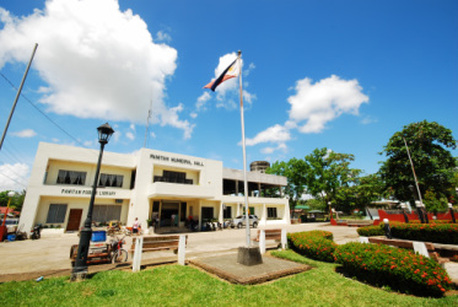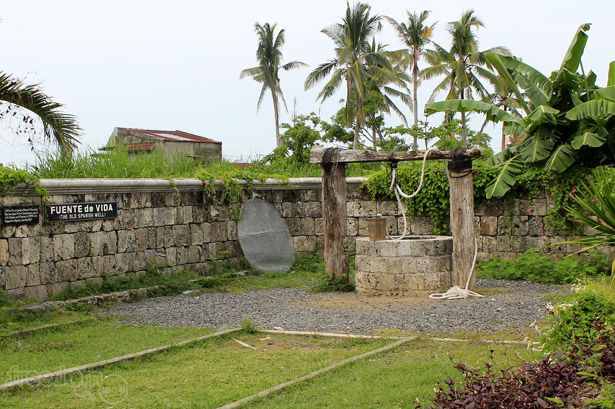History of Pilar
The coastal town sprang out from an Austronesian settlement in the early 16th century when indio natives managed to escape oppression from Spanish colonial authorities. The settlement was then known as Sibala, named after the river that ran through the coastal village. In 1570, however, the settlement was seized by Spanish forces and the guardia civil took full control of the village fortifying it with a military garrison. It later flourished into a bigger town and was renamed after its designated patron La Nuestra Señora del Pilar (Our Lady of the Pillar). In the 18th century, it adopted the (Holy Trinity) La Santisima Trinidad as its municipal patron after a wooden image of the Holy Trinity from the wreckage of a Spanish galleon ship en route from Mexico was found in the town's coastline. Augustinian friars were initially assigned to preach in the town since then until it would later receive its permanent parish priest and Roman Catholic Church.
In 1887, there had been an armed insurgency known as the Battle of Balisong during the Philippine Revolution in an attempt to overthrow Spanish authorities in the municipality led by local revolutionaries with the support of other resistance groups in Capiz, namely from the neighboring towns of Pan-ay and Pontevedra.
In 1949, the sitios and barrios of Aranguel, Culilang, Pandan, Pinamihagan, Cadoulan, Quiajo, Sangcal, Pondol, Marita, Madulano, Jabuyana, Bo-ac, Cabugcabug, Goce Badiangon, Bayuyan, Agbobolo, Cubay, Ibaca, and the sitio of Lotudlotud, which was converted into a barrio of Elizalde, were separated from the municipal jurisdiction of Pilar to form a separate town, namely President Roxas, by virtue of Republic Act No. 374.
Tourist Attraction
Agtalin Shrine
The 85-feet tall statue of Miraculous Medal is considered as the highest Marian statue in Asia. Thousands of devotees flocks every 1st Saturday of the month to Agtalin Hill located at Brgy Dulangan, Pilar, Capiz. You can appreciate the fresh air on top. There are 185 steps of stairs before you could reach the top.
Thousands of devotees flocks every 1st Saturday of the month to Agtalin Hill. It is a religious and solemn place which is suitable for praying and hearing mass.
Lola Ibe
“Lola Ibe” is the remains of Maria de Juan Basañes. It has been existing for 8 decades. After 10 years of her death, her grave was dug up to be replaced by her dead “apo”, it was then discovered that her body had not yet fully decayed. She is said to be a saint by the locals.
Balisong Hill
The Balisong Hill is one of the tourist attractionof Pilar because of ots historical contribution. It is where the famous Battle of Balisong in 1887 happened, between the Casadores-Spanish soldiers and the Pilareño took place. It is located in Brgy. Natividad.
It has a natural beauty because of the forest and white color of rocks. The place is great for hiking, trekking and rock climbing.
Balisong cave
Balisong cave is the graveyard of Balisong Heroes. It is also known as the Butete Cave. The cave has also an archaeological and environmental significance and value. It is untouched with beautiful rock formations. According to a cave expert, its karsts formation and wild-life are unique and its limestones is one of the oldest in Panay Island. The cave is perfect for activities like spelunking.
Puting Bato Cave
Puting Bato Cave is abundant if granite and marbles. Its environmental value is preserved because it is privately owned. Mythically, people believed that the cave is inhabited by spirits that could cause illness and bad luck once it is bothered and destroyed. Inside the cave is an altar formation of rocks and stalacite.
Falls
Hinulugan Falls
The Hinulugan Falls is located in Brgy. Tabunacan. It is one of the most breath-taking tourist attraction in the municipality of Pilar. Enjoy the refreshing and cold water that would revive and invigorate your spirit.. It is surrounded with the natural beauty of nature. For adventurers, hiking could be done going to its final top that takes 20-30 mins.
Lalawgon Falls
Lalawgon Falls is unique because of its S-shaped structure. It is located in Brgy. Yating. It takes 1 kilometer to reach the place perfect for those people who enjoy trekking and adventure. The water from the falls is clean. The area is surrounded witha virgin forest with a beautiful scenery and learn to appreciate nature.
Kawawa Falls
Kawawa Falls is located at Barangay San Silvestre, Pilar, capiz. It is called “Kawakawa”because of its natural formation is shape like a big frying fan. It has falls above it with clear waters flowing down the kawa with 15 feet deep. it has a diameter of round 10 meters and surrounded by “dalipe” or solid rocks. it has a distance of 1.5 kilometers from the Barangay proper and is located near the boundary of San Silvestre & Tabun-acan.
Beach and Reef
Pilar Bay
Pilar Bay covers 10 barangays of the municipality fom Brgy. Dulungan to Brgy. Casanayan and is considered the longest bay in the entire Province. The beach is clean and not over- crowded. It is the main source of fishing industry in the area and nearby municipalities. It is a perfect spot to witness the sunrise and sunset. Pilar municipality waters are also a sanctuary of different marine life.
Tukad Reef
Tukad Reef is a coral reef formation located in the northern part of the municipality. It is a submarine islet of shelled mollusk and corals with layers of sand on top. It is 10 kilometers away from the shoreline of Pilar Bay with an area of 4 hectares. It is seen during low-tide and could only be reached by a boat or raft.





























